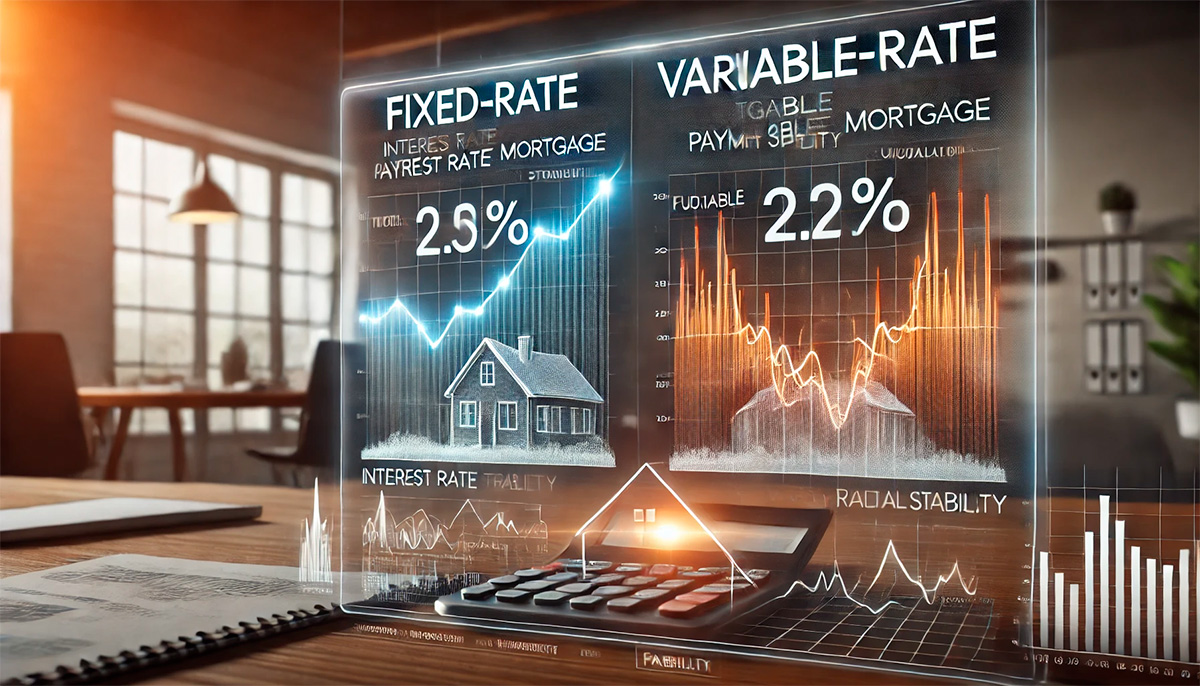
Choosing the right mortgage is one of the most important financial decisions you can make, and deciding between a fixed-rate and variable-rate mortgage is often the first major choice in the process. Both options have distinct benefits and challenges, and understanding the nuances of each can help you make an informed decision that aligns with your financial goals and lifestyle.
This guide explores the essential differences between fixed-rate and variable-rate mortgages, delving into their implications for borrowers with varying needs and risk tolerances.
Understanding Fixed-Rate Mortgages
Fixed-rate mortgages are the cornerstone of stability in the lending world. With this type of mortgage, the interest rate remains unchanged for the entire term of the loan, offering predictable monthly payments. Borrowers who prioritize consistency often find fixed-rate mortgages appealing because they eliminate the guesswork associated with fluctuating rates.
This stability is particularly advantageous during periods of economic uncertainty or rising interest rates. Borrowers lock in a rate that remains constant regardless of external market conditions, providing a sense of security and simplifying financial planning. For example, a family purchasing their first home may find comfort in knowing that their monthly mortgage payments will not increase unexpectedly, allowing them to allocate their budget more effectively.
While fixed-rate mortgages offer predictability, they often come with higher initial interest rates compared to their variable counterparts. This can result in higher monthly payments at the start of the loan, which may deter borrowers who are seeking to minimize costs in the short term. However, the long-term benefits of stability often outweigh the initial financial burden for those planning to stay in their homes for many years.
The Dynamics of Variable-Rate Mortgages
In contrast to fixed-rate mortgages, variable-rate mortgages introduce an element of flexibility. The interest rate on these loans fluctuates over time, typically tied to a benchmark index such as the prime rate or the Secured Overnight Financing Rate (SOFR). This means that the monthly payments can increase or decrease depending on changes in the broader market.
Variable-rate mortgages are particularly appealing to borrowers who are comfortable taking on some level of risk in exchange for potential savings. When interest rates are low, these mortgages often feature lower initial payments compared to fixed-rate options. For instance, a young professional purchasing their first home may opt for a variable-rate mortgage to capitalize on lower rates, freeing up funds for other financial priorities like saving or investing.
However, the inherent unpredictability of variable-rate mortgages requires careful consideration. Borrowers must be prepared for the possibility of rate increases, which could lead to higher monthly payments and financial strain. This type of mortgage is best suited for individuals with flexible budgets or those who plan to sell or refinance their property before significant rate changes occur.
Choosing Between Stability and Flexibility
The decision between fixed-rate and variable-rate mortgages often boils down to a choice between stability and flexibility. Fixed-rate mortgages are ideal for those who prefer a steady and predictable financial outlook. These loans provide peace of mind, particularly for families or individuals on a tight budget who need to plan their expenses meticulously.
On the other hand, variable-rate mortgages cater to borrowers who are willing to accept uncertainty in exchange for the potential to save on interest costs. This flexibility can be advantageous for people who anticipate rising incomes, short-term ownership, or the ability to refinance if rates become unfavorable.
For example, a couple purchasing a starter home with plans to move within five years might benefit from the lower initial costs of a variable-rate mortgage. Conversely, a retiree seeking long-term stability in their financial commitments may find the predictability of a fixed-rate mortgage more appealing.

The Influence of Market Conditions
Economic trends and market conditions play a significant role in determining which mortgage type is more suitable at a given time. During periods of low interest rates, fixed-rate mortgages become particularly attractive because borrowers can lock in historically favorable rates for the long term. Conversely, when rates are high but expected to decline, variable-rate mortgages may offer better value.
In addition to interest rate trends, broader economic factors such as inflation, employment rates, and housing market dynamics can influence the decision-making process. Consulting with a financial advisor or mortgage specialist can provide valuable insights into how these conditions affect mortgage choices, ensuring that your decision aligns with the current economic landscape.
Evaluating Your Financial Situation
Your personal financial circumstances are equally important when choosing between fixed and variable-rate mortgages. Factors such as income stability, savings, and long-term financial goals should all be taken into account. Borrowers with steady, predictable incomes often gravitate toward fixed-rate mortgages for their consistency. In contrast, individuals with fluctuating earnings or a higher tolerance for risk may find variable-rate mortgages more appealing.
It’s also important to consider your future plans. For those intending to stay in their home for the entirety of the loan term, the security of a fixed-rate mortgage is often preferable. However, if you anticipate selling the property or refinancing within a few years, a variable-rate mortgage might better suit your needs.
The Role of Loan Terms
Loan terms also influence the choice between fixed and variable rates. Fixed-rate mortgages are commonly available in terms of 15, 20, or 30 years, offering flexibility to choose a duration that matches your financial strategy. Variable-rate mortgages, on the other hand, often start with a fixed introductory period—such as 3, 5, or 7 years—before shifting to variable rates for the remainder of the term.
Understanding how these terms interact with your financial goals is crucial. For example, a borrower planning to pay off their mortgage quickly might opt for a shorter fixed-rate term to take advantage of lower rates and faster equity building. Conversely, someone seeking lower initial payments might prefer the introductory period of a variable-rate mortgage.
Making an Informed Decision
The choice between fixed-rate and variable-rate mortgages is deeply personal, shaped by individual preferences, financial circumstances, and market conditions. Both options have their merits, and understanding the nuances of each is the key to making the best decision for your situation.
A fixed-rate mortgage offers the security of consistent payments and long-term predictability, making it an excellent choice for risk-averse borrowers or those planning to stay in their homes for many years. Meanwhile, a variable-rate mortgage provides flexibility and the potential for cost savings, appealing to individuals who are comfortable navigating the uncertainty of fluctuating rates.
Consulting with a mortgage professional and conducting a thorough analysis of your financial situation will help you determine which option aligns best with your needs. By carefully weighing the pros and cons of each mortgage type, you can make a confident decision that supports your goals and sets the stage for financial success.
